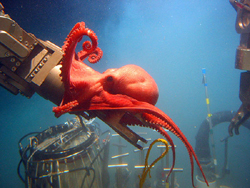Deep Sea Octopus
Common Name: Octopus
Scientific Name: Octopus vulgaris (Common octopus)

Description
Octopuses are characterized by their eight arms (as distinct from the tentacles found in squid and cuttlefish), usually bearing suction cups. These arms are a type of muscular hydrostat. Unlike most other cephalopods, the majority of octopuses - those in the suborder most commonly known, Incirrina - have almost entirely soft bodies with no internal skeleton.
Range & Habitat
This octopus is found from the southern North Sea down to South Africa. It also occurs in the Mediterranean. It reaches the north-eastern extreme of its range in Britain where it is found only around the coasts of the south and south west.
It occurs along rocky coasts in the shallow sublittoral zone.
Octopus in nature
Octopuses have a relatively short life expectancy, and some species live for as little as six months. Larger species, such as the North Pacific Giant Octopus, may live for up to five years under suitable circumstances.
Octopuses have three hearts. Two pump blood through each of the two gills, while the third pumps blood through the body. Octopus blood contains the copper-rich protein hemocyanin for transporting oxygen. Although less efficient under normal conditions than the iron-rich hemoglobin of vertebrates, in cold conditions with low oxygen pressure, hemocyanin oxygen transportation is more efficient than hemoglobin oxygen transportation.
Intelligence
Octopuses are highly intelligent, probably more intelligent than any other order of invertebrates.An octopus has a highly complex nervous system, only part of which is localized in its brain. Two-thirds of an octopus's neurons are found in the nerve cords of its arms, which have a remarkable amount of autonomy. Octopus arms show a wide variety of complex reflex actions arising on at least three different levels of the nervous system. Some octopuses, such as the Mimic Octopus, will move their arms in ways that emulate the movements of other sea creatures.
Reproduction
When octopuses reproduce, males use a specialized arm called a hectocotylus to insert spermatophores (packets of sperm) into the female's mantle cavity. The hectocotylus in benthic octopuses is usually the third right arm. Males die within a few months after mating. In some species, the female octopus can keep the sperm alive inside her for weeks until her eggs are mature. After they have been fertilized, the female lays about 200,000 eggs.The female does not eat during the roughly one-month period spent taking care of the unhatched eggs.
 Deep Sea Crabs
Deep Sea Crabs